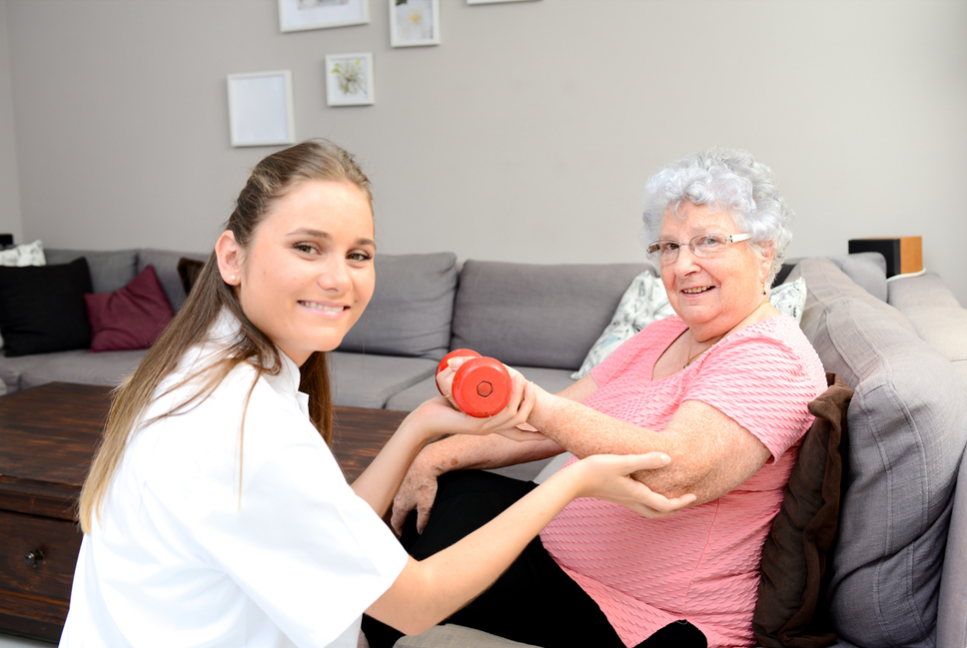 February 15, 2017
February 15, 2017
Exercise is necessary for everyone! Research has shown that regular exercise with the help of a physical therapist can improve the quality of life for Parkinson’s patients. As the second most common neurological disorder, Parkinson’s disease affects a lot of patients and their families. Many of these families are seeking in home physical therapy services to help their loved ones manage their symptoms.
Knowing your loved one is getting the best physical therapy at home can help put your mind at ease. Receiving care from the comfort of home gives your loved one the ability to live their life to the fullest. To ensure your loved one is getting the care they need, here are the steps you should know to make sure you’ve found a good physical therapist.
Seek a Licensed Practitioner
Only a licensed physical therapist or physical therapy assistant should be providing in home care to your loved one. Remember, state licensure is required in the U.S. for physical therapy practices, and each state has an agency that oversees regulations. If you have questions about licensing or would like to verify that your loved one’s physical therapist has a license, you can do so by contacting the in home care provider or checking the Federation of State Boards of Physical Therapy.
Know Who You Need on Your Team
Licensed physical therapists and physical therapy assistants perform many of the same basic responsibilities, and both can be of great help to patients. However, their level of education and responsibilities do differ. Understanding the duties and education requirements to be a practicing physical therapist or physical therapy assistant can help you feel confident when selecting a caregiver you can trust to provide great care for your loved one.
Here’s the breakdown of the educational requirements to be a physical therapist or a physical therapy assistant and their responsibilities:
Education
Physical Therapist (PT
- Postgraduate professional degrees
- Most have a Doctor of Physical Therapy (DPT)
- DPT degree generally requires prerequisites like anatomy, biology, chemistry, and physiology
Physical Therapist Assistant
- Generally, states require an associate’s degree from an accredited physical therapy program
- Programs involve first-hand clinical experience and academic coursework
Certification and Licensing
Physical Therapist (PT
- States require PTs to have a physical therapist license to practice
- Must pass the National Physical Therapy Examination or state-administered exam
- Some PTs choose to be certified in a clinical specialty, and need to pass additional exams
Physical Therapist Assistant
- Must graduate from an accredited physical therapy assistance program
- Need to have passed the Physical National Physical Therapy Exam
- Some states require an additional state-administered exam
Duties
Physical Therapist (PT
- Diagnose and deliver care to individuals
- Develop rehabilitation plans for patients
- Teach stretches, exercises, and hands-on therapy
Physical Therapist Assistant
- Determine the level of patient injuries and report findings to a physical therapist
- Educate the patient about what to do post-treatment
- Help with exercises and stretches
- Instruct patients how to use equipment and devices
Ask About the Therapist’s Experience with Parkinson’s
All licensed physical therapists should be able to assist Parkinson’s patients, but some are more prepared than others. During an interview, you should ask the home care provider or physical therapist about their experience with Parkinson’s disease. For example, ask the physical therapist if they have a history of treating people with neurological disorders, have completed a residency or fellowship in neurological physical therapy, or have achieved additional certifications for Parkinson’s care.
Here are some examples of certifications that are available for physical therapists for Parkinson’s that you should ask about:
- LSTV BIG Program
- LSVT® LOUD Program
- PWR!Moves™ Trained Therapist
- Parkinson’s Disease: A Practical Approach to Evaluation & Treatment for the Physical Therapist
Make Sure Your Therapist is Up-to-Date
Since there is no standard treatment for Parkinson’s disease, treatment is based on your loved one’s symptoms. New methods for how to manage the symptoms of Parkinson’s are constantly on the horizon, so you should ask the physical therapist how they stay up-to-date and how they use best practices to provide care.
Good physical therapists will be able to answer these questions by naming scientific journals they read, courses they have taken, and certifications they have received. Great physical therapists will be able to answer your questions and also explain to you how their up-to-date knowledge and methods will benefit your loved one.
Find a Compassionate Person
Aside from their training and credentials, you should look for a physical therapist who has compassion and fosters good working relations with the whole care team, especially you and your loved one. You want a physical therapist who not only knows how to handle the specifics of Parkinson’s treatment, but also takes account of the whole person, not just their specific condition or injury. A good physical therapist will listen to your loved one’s needs, follow through with the plan of care, and keep you updated on their treatment.
If your loved one has a physical therapist you are unhappy with, you have the right to choose a new one. In the U.S., you and your loved one have the right to contact a physical therapist for in home care without a physician’s referral and select one that is right for your needs. If you are interested in finding a new trained and certified physical therapist or physical therapy assistant to provide in home physical therapy, we can help.



